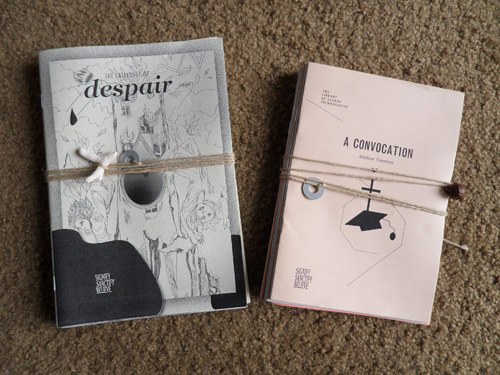
The Library of Sacred Technologies (LoST).
In historical studies of the sweeping changes brought about by the invention of the printing press, it has been noted that the wide availability of published materials played a significant role in religious movements. In particular, the success of the Protestant Reformation owed a great deal to Martin Luther’s ability to circulate his self-published 95 Theses pamphlet amongst a widespread audience, convincing multitudes to study the bible for themselves and to form a “priesthood of all believers” instead of relying on the services of a corrupt Catholic church. Some pop historians look to that pamphlet as the first ancestor of the modern zine, in that it communicated one individual’s radical ideas directly to the public.
The tradition of religious pamphleteering continues today in a less radical form throughout the various churches of America; it is not uncommon to stumble across small, appealing, cheaply-produced booklets that try to convince the reader, through a variety of folksy approaches, to take up the path of Jesus. In a more sophisticated incarnation, the glossy Jehovah’s Witness Watchtower publication, launched in 1879, is now one of the most widely-circulated magazines in the world. In Los Angeles, which has its own significant history of alternative spiritual practices, we find this centuries-old religious pamphleteering tradition beautifully tapped into, and gently reshaped, by the Library of Sacred Technologies (LoST), the experimental publishing platform of Signify, Sanctify, Believe (SSB), an ongoing project conceived and executed by artists Claire Cronin, Adam Overton and Tanya Rubbak.

A still from Signify, Sanctify, Believe’s “Welcome” video featuring, from left to right: Claire Cronin, Tanya Rubbak and Adam Overton. Courtesy the artists.
SSB is performed as a new age cult, complete with a YouTube recruitment video that reaches out to the spiritually curious. Alongside LoST, the other branch of the project is called The Saints and Servants of the Order of [Con]Temporary Religious Observance, under which the group hosts “artist-led religious services and sermons”—events and workshops that play on ideas of faith, worship and magic. Past projects have included a pilgrimage to West Coast spiritual sites culminating in a weeklong residency at Xhurch, a repurposed church and arts venue in Portland, and an extended stay at Lauren Mackler’s temporary Church of Public Fiction in Los Angeles. Events within the projects have included guided meditations, readings, talks, massages, divinations, and consultations. At once sincere and playful, SSB’s inquiries into the sacred are seamlessly conflated with artistic practice and collaboration; as the group noted in a 2011 interview with L.A. Record, “Both [religion and avant-garde art practice] propose to offer either a new system of belief, and/or the desire to chip away at one’s previous set of beliefs, and present to us a queer landscape full of unknown potential.”
LoST includes audio and video recordings but primarily consists of a collection of artist-generated pamphlets (also available for download online as PDFs) that are all designed by Rubbak. At one of SSB’s recent events, I purchased a set of these beautiful publications, which came complete with custom wrapping. Cheaply self-published, they look and feel just like the pamphlets I might find at my local church. All are lovingly designed. Some pieces are direct plays on religious tracts, such as Mathew Timmon’s freestyle A Convocation, or the hilarious New Religious Examiner, which purports to list the best new sects and cults in North America, including such gems as Boner Deities, Burnt-Out Shamanism, Whole Foods Shopping Cult, and You Just Had to Be There Cult. Others are catalogues that collect texts from past events, such as the Experimental Meditation Marathon or the Church of Despair. Still others are totally unclassifiable works like Oona Gardner’s A Gift to the Hidden People, which describes her ritual for placating the deities of a fishing village in Iceland, or Jonathan Butt’s Low Relief, which pictures the lives of flatfish and mold colonies.
I can’t help but think of Luther and his contemporaries, who regarded the invention of printing as an act of God aimed at helping them spread the Protestant message. Printing was, in Luther’s own words, “God’s highest and extremest act of grace, whereby the business of the Gospel is driven forward.”(1) For him, the very existence of print technology was inextricably woven together with his spiritual beliefs, and was part and parcel of his mission on this earth. So it is with LoST, which Rubbak sees as equal parts religious tracts and artists’ zines, influenced as much by their founders’ religious backgrounds as by Fluxus and Dada. As such, they take Luther’s 16th century message of humanistic empowerment and update it with a 21st century-interest in interactive, open-ended forms of experimentation; in place of determinism, LoST offers non-committal and constantly unfurling possibilities.
Footnotes
(1) Elizabeth L. Eisenstein, The Printing Revolution in Early Modern Europe (Cambridge, 2005), 165.



